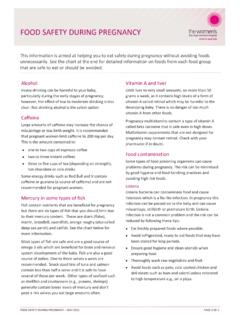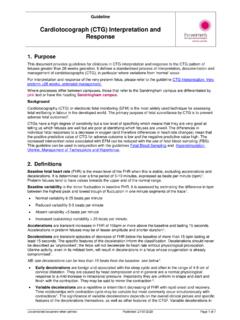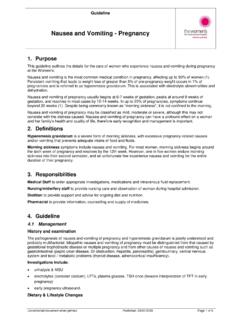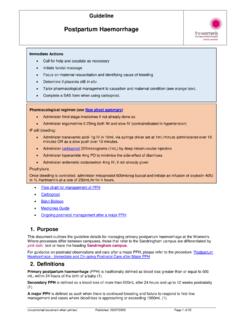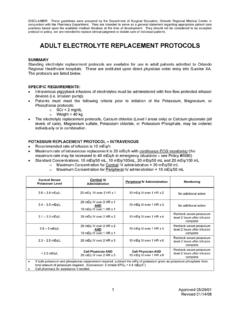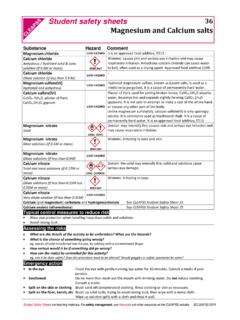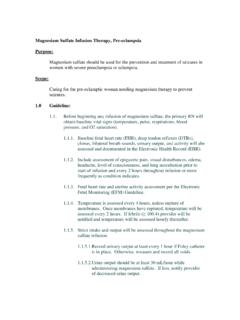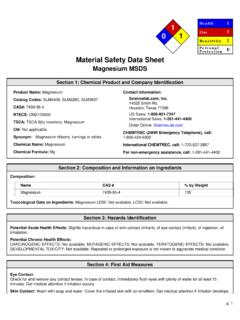Transcription of Magnesium Sulphate - Management of Hypertensive …
1 Guideline Magnesium sulfate - Management of Hypertensive Disorders of Pregnancy Uncontrolled document when printed Published: 29/07/2020 Page 1 of 7 1. Purpose This document outlines the guideline or procedure details for the indications, contraindications, administration and monitoring of Magnesium sulfate ( Sulphate ) use at the Women s. Magnesium sulfate is the anticonvulsant of choice for pre-eclampsia prophylaxis and treatment and treatment of eclampsia. It is the first-line treatment for any pregnant woman who suffers a seizure, including women with known epilepsy. Also refer to Procedures: Observations Birth Centre and Assessment Adult Escalation Criteria and Response Framework and Seizures during Pregnancy- Assessment and Management . Where processes differ between campuses, those that refer to the Sandringham campus are differentiated by pink italic text or have the heading Sandringham campus.
2 2. Definitions Magnesium sulfate is a synonym for Magnesium sulfate heptahydrate. 3. Responsibilities Obstetric medical staff and students under supervision Midwifery staff and students under supervision Anaesthetic medical staff 4. Guideline Indications for use Magnesium sulfate is used in pregnancy: for women with pre-eclampsia for whom there is concern about the risk of eclampsia first-line Management of an eclamptic seizure first-line treatment of any seizure during pregnancy neuroprotection of preterm infants. Immediate actions Use as first-line treatment for any pregnant woman who suffers a seizure, including women with known epilepsy. Note that the equipment for IV infusion process is different for Parkville and Sandringham- refer to appropriate section. Caution should be taken with any additional intravenous fluid administration to manage hypotension because of the potential risk of pulmonary oedema AVOID POLYPHARMACY to treat seizures as this will increase the risk of respiratory arrest.
3 Guideline Magnesium sulfate - Management of Hypertensive Disorders of Pregnancy Uncontrolled document when printed Published: 29/07/2020 Page 2 of 7 Presentation 10mL = 500mg/mL (50% solution) ( Magnesium sulfate heptahydrate). Route of administration IV infusion: Magnesium sulfate is delivered by controlled infusion via a syringe pump or Alaris PC pump. The infusion is connected via: a multi-flow adapter to a peripheral line of normal saline and monitored by an infusion pump in order to reduce localised irritation and monitor fluid balance. The Magnesium line should be labelled clearly and not used to inject other medicines. Note: Magnesium sulfate infusions should only be administered in Birth Centre, Theatre or Complex Care Unit Dose Prophylaxis of pre-eclampsia seizure Note: preparation differs across Parkville and Sandringham campuses Loading dose: using a 10mL vial of Magnesium sulfate prepare 4 gram ( 8mL) of Magnesium sulfate 50% in a 10mL syringe, configure the pump to accept the 10mL syringe and set the pump to 32mL/hr for 15 minutes.
4 Maintenance rate: once the loading dose has been completed, use the prepared 25g in 50mL Magnesium sulfate syringe and re-set the pump to accept the 50mL syringe. Set the pump to administer the maintenance rate of 1g/hr (2mL/hr) or as ordered, until at least 24 hours post birth/delivery. NB: Ensure Magnesium Sulphate is administered concurrently via a Y-site with a compatible IV fluid. Sandringham Campus Using the prepared 25g in 50mL Magnesium sulfate syringe, the Alaris PC Infusion pump can be programmed to accept BOTH the loading dose (32mL/hr for 15 minutes AND the maintenance dose (2mL/hr) as stated above. There is no need to change the syringe as the Alaris pump allows for both settings. Refer to appendix 1 for set up instructions. Side effects: hypotension secondary to reductions in systemic vascular resistance facial flushing visual disturbances flushing at injection site chest pain nasal stuffiness.)
5 NOTE: caution should be taken with any additional intravenous fluid administration to manage hypotension because of the potential risk of pulmonary oedema. The following may also occur: ECG changes circulatory collapse gastro-intestinal upset Guideline Magnesium sulfate - Management of Hypertensive Disorders of Pregnancy Uncontrolled document when printed Published: 29/07/2020 Page 3 of 7 urinary retention Magnesium toxicity tissue necrosis at the injection site. Contraindications and precautions Magnesium sulfate should be administered with caution in women being treated with cardiac glycosides/digitalis. Concurrent use of Magnesium sulfate and CNS depressants may result in an enhanced CNS depressant effect. If Calcium Gluconate is required to treat Magnesium sulfate toxicity, it should be delivered with caution as it may precipitate heart block.
6 As Magnesium is excreted in urine, patients with impaired renal function or electrolyte imbalance should be managed cautiously and Magnesium levels should be monitored closely because of the increased risk of Magnesium toxicity. Initial and subsequent Management of eclamptic seizures The priorities are to terminate the seizure and prevent maternal and fetal hypoxia. The first line of treatment for a woman who is having an eclamptic seizure is supportive care which should follow the basic principles for maintaining the woman s airway, breathing and circulation. Refer to: the procedure Eclampsia: Management . Call for help and initiate: Code Blue - Adult and Child. SANDRINGHAM: Obstetric Emergency Code Do not leave the woman alone. Assess the situation in regards to safety of staff and patient.
7 Aim to prevent maternal injury during the seizure. Position the woman into the left lateral position and administer oxygen by mask. Continue to assess AIRWAY, BREATHING, CIRCULATION Secure IV access. Check maternal pulse and blood pressure. Use pulse oximetry if available. Magnesium sulfate is the most effective medicine for the treatment of seizures when administered to women with eclampsia. Guideline Magnesium sulfate - Management of Hypertensive Disorders of Pregnancy Uncontrolled document when printed Published: 29/07/2020 Page 4 of 7 AVOID POLYPHARMACY to treat seizures as this will increase the risk of respiratory arrest. Note: If a maintenance infusion is in progress, cease the infusion. Give LOADING DOSE: draw up 4g (8mL) of Magnesium sulfate 50% in 10mL syringe administer intravenously over ten (10) minutes slow IV push Commence/re-commence maintenance infusion.
8 REMEMBER to check ALL pump limits when recommencing the infusion. Note: ECG monitoring should be available and anaesthetists are to be advised of the woman s medical condition. Recurrent seizures should be treated with a further bolus dose of 4g (8mL) Magnesium sulfate . Monitoring Magnesium level monitoring The therapeutic level of Magnesium : to mmol/L. Routine monitoring of Magnesium levels is not required BUT as Magnesium is excreted by the kidneys, monitoring of serum levels should be conducted in women with renal impairment (6 hourly or more frequently as indicated). Request Magnesium level and review Management if: respiratory rate < 12 breaths/minute urine output < 100mLs in 4 hours loss of patellar reflexes further seizures occur. Mg conc (mmol/L) Effects - normal plasma level - therapeutic range - ECG changes (P-Q interval prolongation, widen QRS complex) - reduction in deep tendon reflexes > loss of deep tendon reflexes > sinoatrial and atrioventricular blockade.
9 Respiratory paralysis and CNS depression > 12 cardiac arrest Note: If serum Magnesium level is > , cease infusion and consult with obstetrician. Clinical observations During administration of the loading or bolus dose: 5 minutely blood pressure and pulse (x 4 readings) observe for the development of side effects check patellar reflexes after administration. Guideline Magnesium sulfate - Management of Hypertensive Disorders of Pregnancy Uncontrolled document when printed Published: 29/07/2020 Page 5 of 7 During administration of the maintenance infusion: hourly blood pressure, pulse, and respiratory rate (pre-treatment respiratory rate should be 16per minute). These may be undertaken hourly post-birth. 1 hourly patellar reflexes 1 hourly urine measures, 4 hourly testing of urinary protein 2 hourly temperature continuous electronic fetal monitoring from 26 weeks gestation until clinical review/discussion by medical staff.
10 Between 24- 26 weeks gestation, individualised Management with regard to fetal monitoring will be considered maintain strict fluid balance chart. Record patellar reflexes as: A = Absent N = Normal B = Brisk Response to Magnesium toxicity The following clinical signs of Magnesium toxicity must be reviewed by a consultant obstetrician/anaesthetist: urine output <100mL in 4 hours absent patellar reflexes respiratory depression. The antidote for Magnesium toxicity is: 10mL calcium gluconate (available as of calcium in 10mL vial- formerly known as 10% solution) over 10 minutes by slow intravenous injection. The patient requires ECG monitoring during and after administration because of the potential for cardiac arrhythmias. Resuscitation and ventilator support should be available during and after dose administration of both Magnesium sulfate and calcium gluconate.
